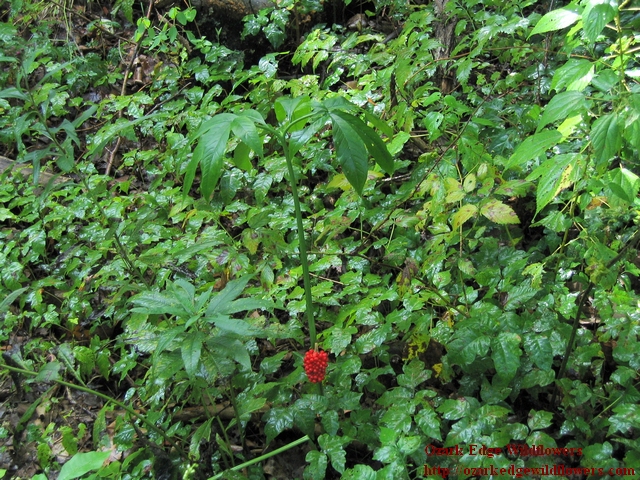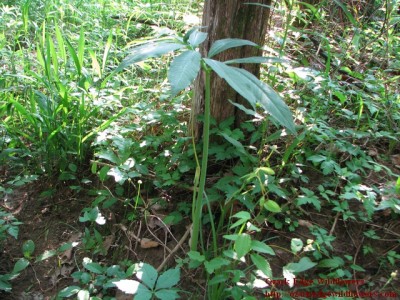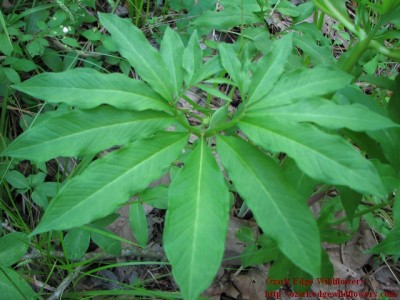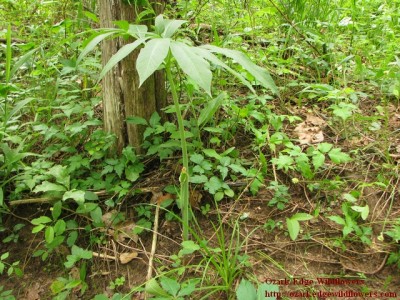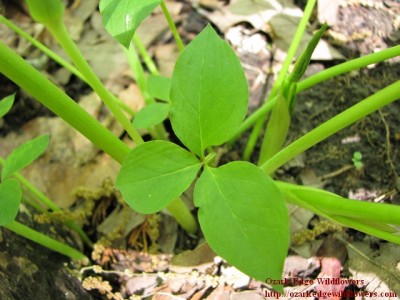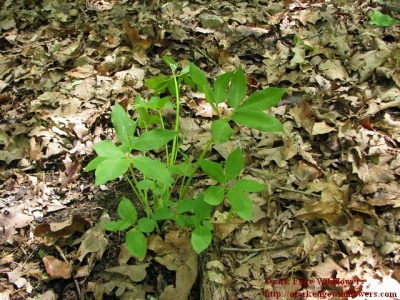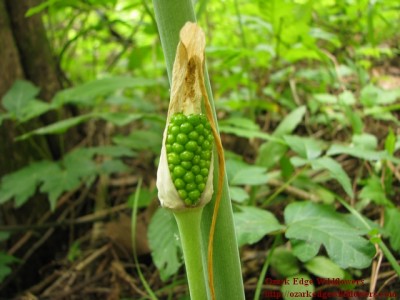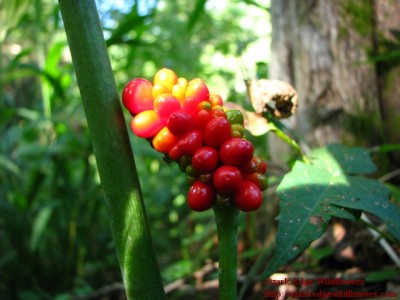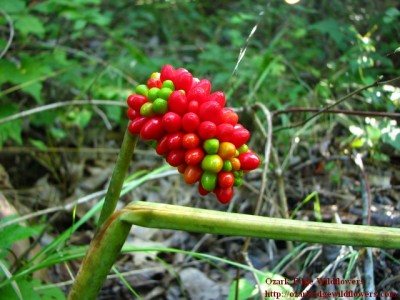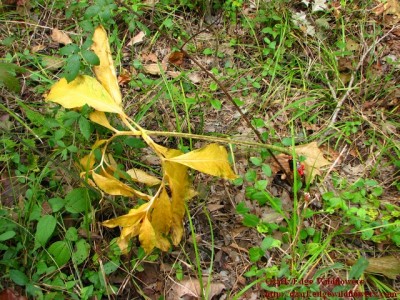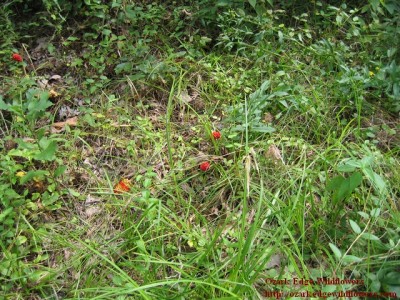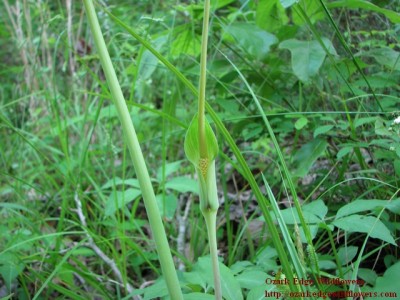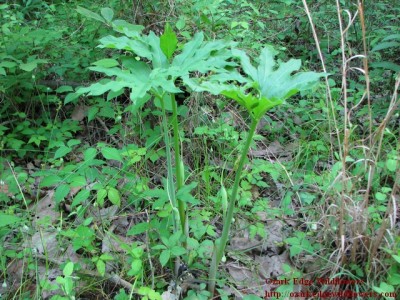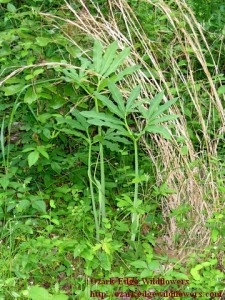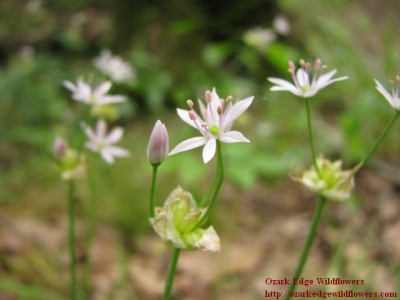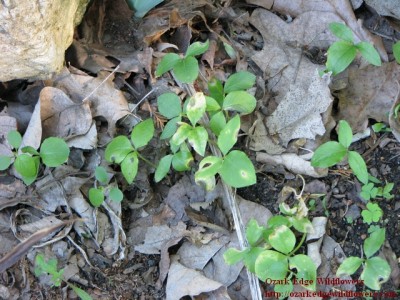My first encounter with Arisaema dracontium occurred during a lazy horseback ride on a late summer afternoon. The crimson berries were hard to miss among the greenery of the lush creek bank. My horse, as usual, was not very interested in my botanical discovery, so I returned later, camera in hand to identify my find.
Latin Name/Common Name- Green dragon also goes by the common names Dragon arum and Dragon root. It takes some imagination to match the name with the plant. The flower spathe somewhat resembles the fire breathing dragon with the spreading leaf representing the dragon wings.
Arisaema is a combination of two Greek words, “Aris” meaning arum and “haema” meaning blood. Arisaema dracontium is in the Arum family. A closely related plant of the same family is Arisaema triphyllum or Jack-in-the-pulpit. These two plants are reported to often grow near one another. Jack-in-the-pulpit is found throughout the Ozarks, but I haven’t encountered it on Ozarkedge. I’ll keep looking.
Bloom Color- The flower is on a stalk that branches from the leaf stem near the ground. The yellow-green flowers are enveloped by a green overcoat, known as a spathe.
Flowers inside the spathe
From the top of the flower, a long, tapering wand emerges. This is termed a spadix.
Green dragon in bloom showing long, tapering spadix
Description- This exotic looking plant has a single leaf that is highly dissected into 5-15 deep lobes. The dark green leaf is huge, reaching more than a foot across on mature plants. The stem is smooth, thick and tall. Plants range from1-4 ft in height.
Highly dissected, single leaf of Arisaema dracontium
Mature Green dragon plant
Immature plant at the beginning of May
Group of Green dragon before blooming in early May
Although the leaf and bloom are exotic in appearance, the most spectacular aspect of this plant is the crimson berries that appear at the cusp of summer and fall. Green berries appear shortly after the bloom fades in late May to early June. The berries are clustered together like a short ear of corn. They gradually ripen over the next couple of months, first turning yellow-green, then orange and finally bright crimson by late August.
Green berries May 31st
Two images showing ripening berries
As the berries ripen, the stem- once strong and stout- weakens and bends to the earth. By mid September, the huge leaf has faded to yellow. In October, only a few berries are left to mark the place where the leaf will re-emerge in spring.
As the berries ripen, the stem becomes weak and falls to the earth
The yellowing leaf in September
Group of Green dragon berries in September
All parts of Arisaema dracontium are poisonous. This is related to the calcium oxalate crystals (and other toxins) in the plant. If ingested, intense burning of the throat, lips and tongue will occur.
Bloom Time- Arisaema dracontium blooms in mid May on Ozarkedge. The bloom time may extend into June, but green berries have replaced most of the blooms by then.
Flower with spathe and spadix in mid May
Habitat- On Ozarkedge, Green dragons live in the lush growth found alongside creek beds and in low damp places at the woodland edges. They like growing in the boggy areas that are often flooded when the lake creeps past its usual borders in spring and fall.
Three Green dragons in area regularly flooded each spring
What’s Growing Nearby?- Poison ivy is a common companion of Green dragon. Since I am highly allergic, I have to be on the constant look out for the “leaves of three” when I am in the vicinity. Grasses, sedges and wild garlic also grow nearby.
Arisaema dracontium with grasses, poison ivy and wild garlic companions
Allium canadense or Wild garlic grows near Green dragon
Endangered List- If you find this fascinating plant in the wild, leave it be. It is an uncommon plant. The USDA plant site lists it as Threatened in Vermont and Massachusetts. It is considered Exploitably Vulnerable in New York and Endangered in New Hampshire.
Click here to see the latest status on the USDA Plants Database. This link should take you to the General page showing a map with US distribution. Click on the Legal tab on to see the latest updates on its Threatened and Endangered status.
I have successfully propagated Green dragon by taking one of the berry clusters, drying it, and then lightly planting in the fall. The next spring, I was rewarded with numerous new plants.
Berries planted the previous fall gave rise to this group of young Green dragons
Interesting Tidbits- This plant is a sex change artist. In plants this is called gender diphasy. When small and young, Arisaema dracontium is typically male. When larger, it becomes female. In fact, it may change sex from year to year depending on ecological factors such as weather.
